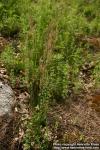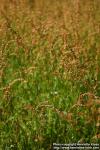
 Related entry: Rumex (U. S. P.)—Rumex - Oxalis.—Wood-Sorrel - Acidum Oxalicum.—Oxalic Acid
Related entry: Rumex (U. S. P.)—Rumex - Oxalis.—Wood-Sorrel - Acidum Oxalicum.—Oxalic Acid
The leaves of Rumex Acetosa, Linné.
Nat. Ord.—Polygonaceae.
COMMON NAME: Sorrel.
Botanical Source.—Rumex Acetosa has a long and tapering, somewhat woody root, with an erect, simple, leafy, striated stem, 1 or 2 feet high. The lower leaves are petiolate, somewhat ovate, and narrow-shaped, with 2 lateral teeth; the upper ones sessile, more oblong, and narrower. The stipule is tubular, membranous, and fringed. Clusters erect, compound, whorled, and leafless. Flowers dioecious; males green, with a reddish tinge; inner sepals ovate, rather larger than the outer; females rather redder; inner sepals ovate, obtuse, red, entire, each bearing an oblong, Sale tubercle. The whole herb is smooth and powerfully and agreeably acid. The root is astringent. The plant is common to England, and is sometimes cultivated in this country (L.).
History and Chemical Composition.—The leaves of this and the following plant (see Rumex Acetosella) are the parts used in medicine. They are inodorous, and have an agreeable, acid, slightly astringent taste. The leaves chiefly contain acid oxalate (binoxalate) of potassium, tannic acid, and nitrogenous matter. By drying, their acidity is lost. They are used alone, or in the form of an infusion of the fresh leaves. The root contains a substance allied to crysophanic acid, and an iron-greening tannin. In the early stage of its growth, it abounds in oxalic acid (5 per cent soluble, and about 9 per cent insoluble).
(As to the distribution of oxalic acid at different seasons of the growth of the plant, see Berthelot and André, Amer. Jour. Pharm., 1886, p. 500.)
Action, Medical Uses, and Dosage.—Fresh sorrel leaves are refrigerant and diuretic. An infusion is useful in febrile and inflammatory diseases, and in scorbutic diseases. They may likewise be used as a salad, or boiled like spinach. The leaves, eaten freely, have produced poisonous effects, owing to the potassium binoxalate they contain (see Amer. Jour. Pharm., 1887, p. 7). In poisoning by this agent the same treatment should be pursued as for poisoning by oxalic acid, viz.: the free administration of chalk suspended in an abundance of water; this should be followed by an emetic or stomach-pump, and subsequently by lenitives. Wrapped up and roasted, the leaves form an excellent application to indolent tumors, wens, boils, etc., hastening suppuration. The inspissated juice, applied on leather, is said to form an effectual but painful cure for tumors, and the improbable claim has been made that it will cure incipient cancers. Acting upon this hint, the following preparation has been used as a remedy in cutaneous cancers, viz.: Take of burnt alum, 1 drachm; citric or tartaric acid, 2 drachms; oxalic acid, 2 drachms; rain-water, ½ pint. Mix. To be applied by means of a camel's-hair pencil.

 Related Species.—Rumex Acetosella, Linné, Field or Sheep sorrel, has a leafy stem, from 6 to 12 inches in height, with lanceolate-hastate, pleasantly-acid leaves. The flowers are small, reddish, in panicled racemes. Valves ovate, scarcely enlarging in fruit, destitute of granules. Stamens and styles on separate plants; styles adherent to the angles of the ovary. This weed is found in abundance throughout the United States, growing in pastures, waste grounds, and worn fields, flowering all summer (G.—W.).
Related Species.—Rumex Acetosella, Linné, Field or Sheep sorrel, has a leafy stem, from 6 to 12 inches in height, with lanceolate-hastate, pleasantly-acid leaves. The flowers are small, reddish, in panicled racemes. Valves ovate, scarcely enlarging in fruit, destitute of granules. Stamens and styles on separate plants; styles adherent to the angles of the ovary. This weed is found in abundance throughout the United States, growing in pastures, waste grounds, and worn fields, flowering all summer (G.—W.).
A strong tincture of the fresh plant (℥viii to alcohol, 76 per cent, Oj), in doses ranging from 1 to 30 drops, has been suggested by Dr. Scudder (Spec. Med.) as a remedy where there is a "tendency to degeneration of tissue," and he states that whether "in syphilis, scrofula, or cancer, the indication for its use is the replacement of tissue with lower organizations." The urinary apparatus and renal secretions are influenced by it.

